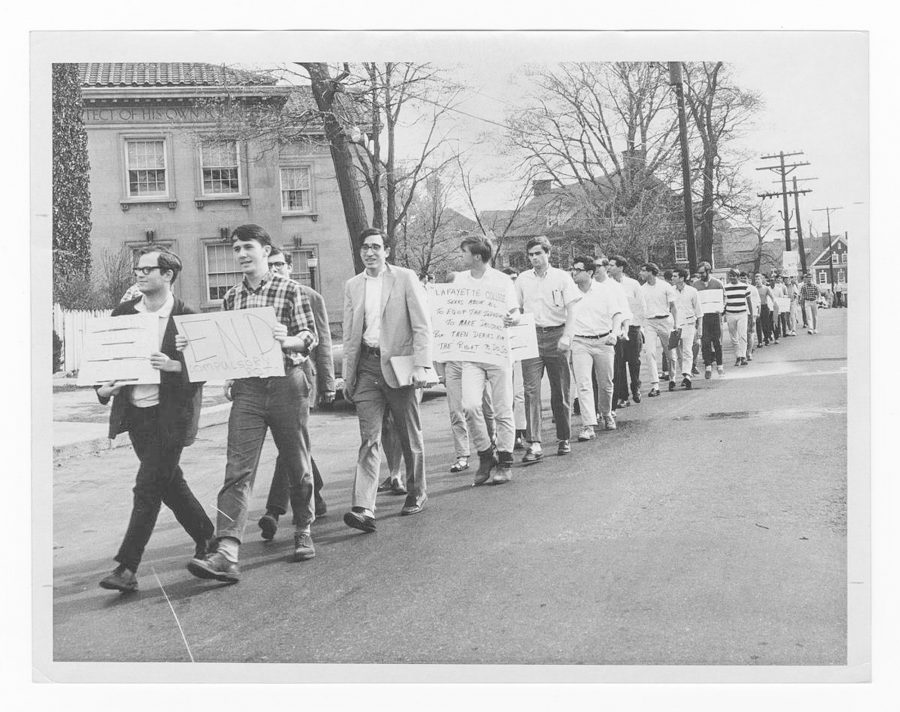Much like the contemporary political climate, the 1960s were a tumultuous time for activism, social justice and cultural change across the United States. And like the student protests we see today, Lafayette’s campus was not immune to this trend.
Demonstrations and protests took place throughout the decade supporting a variety of causes. Most revolved around the anti-war sentiment and the start of a youth culture. One cause championed by Lafayette students at the time was the protesting of the Reserve Officers’ Training Corps (ROTC) program established at the college in the early part of the decade.
In the spring of 1963, anti-war protests broke out at Princeton University and the University of Pennsylvania. The day after the Princeton protest, a firecracker was thrown during a Lafayette ROTC event.
Compulsory participation in the ROTC program and America’s involvement in the Vietnam War were both contentious issues among the student body. In the spring of 1967, about 50 Lafayette students organized a peaceful demonstration against compulsory ROTC.
A few days later, the same students held a silent vigil outside Marquis Hall protesting American involvement in Vietnam. In the fall of that year, students protested against ROTC and the local Easton draft board citing “alleged undemocratic aspects of the College disciplinary code,” Thomas Lannon, director of special collections and college archives, said.

In January of 1968, the Students for Democratic Reform (SDR) submitted their constitution to the Student Council. In the spring, the group organized a demonstration against American involvement in Vietnam.
SDR urged the Student Council to declare April 21-27 “Vietnam Week,” a week in which students could voice their opinions about the war. This was never officially declared, but the group organized a teach-in about the draft at which an ACLU representative talked to students. At the end of the week, 100 students shared a meal of rice and held a funeral march to Hogg Hall, where they read anti-war poems and sang anti-war songs. Neighboring fraternities played loud rock music in solidarity.
Even employers visiting Lafayette weren’t immune to anti-war protests. In March of 1968, students protested the Dow Chemical Company, the producer of napalm dropped on Vietnam, while Dow was on campus interviewing students for jobs.
Despite the repeated protests, those in opposition to the Vietnam War and ROTC program were a minority on Lafayette’s campus. However, professors such as James R. Vitelli and Chaplain F. Peter Sabey inspired students to protest against the war in Vietnam.
Lafayette students also took part in protests that occurred off-campus. In August 1963, a few students and the dean of the college participated in the March on Washington civil rights protest.
“That was a huge moment for consciousness-raising, as white, privileged people become more aware of the suffering that was happening in the South,” Lannon said.
In the fall of that year, John F. Kennedy’s assassination rocked the campus.
“The assassination of JFK made people more aware of the political tensions that were present in American society because a president was assassinated, and Kennedy would have been someone that certain students looked up to. His assassination was a huge moment for the college student,” Lannon said. “Imagine if a president that you associated with the future was gunned down.”

The elections of 1964 and 1968 also caused political tension. In the spring of 1964, students supporting candidate Barry Goldwater wanted to screen a controversial film called “Operation Abolition,” a government-made film that supported the House Committee on Un-American Activities’ anti-communist position on the American Communist Party.
To Lannon, the occurrence of Woodstock in 1969 represents the spirit of the “youth culture” emerging at the time.
“It’s this coming together of young people where the revolts are not simply trying to instigate change through a new beginning, but it’s about promoting joy. There’s this sort of joyful moment, and I think that’s part of the spirit of Lafayette,” he said.
“The intention behind some of the protests were, in some cases, simply to have fun, mess things up, cause trouble. In some cases, they were about raising the consciousness around social justice,” Lannon continued.




































































































